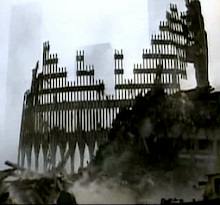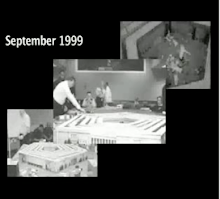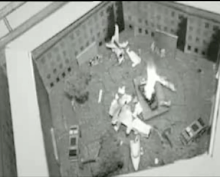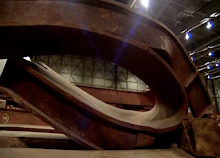This review does not champion a "no plane" theory only that the account presented by the BBC is contradictory and illogical.
"Hoffmann follows the pattern of the WTC animations created by MSC for FEMA, the PBS NOVA animations plus others for NIST. All these claimed “simulations” adjusted the data inputs until the result they required appeared."[23:20] C Hoffmann: "We wanted to understand what did the damage, was it the plane, was it specific parts of the plane, was it the fuel"? What about the engines?
The Hoffman simulation is based on the official explanation that a Boeing 757 hit the Pentagon.

CLICK EXTRACT^ An image from Purdue's computer "simulation" of the blast at the Pentagon. The plane is skimming the ground at approx 550 MPH having "jumped" over a nearby motorway. This image does not fit with the flight data recorder released by the Pentagon nor with aviation science, as quoted by experienced pilots and aeronautical engineers. Aerial photos show no damage to the lawn.
Purdue web site page about the computer graphics "explanation"
September 11 Pentagon Attack Simulations
Using LS-Dyna Extract

CLICK for Enlargement^ Annotated transcript at end of copy below.
In this two minute slot the BBC introduces the, so called, “independent” boffin with colourful “Play Station” animations to answer a question no one has asked.
Christopher Hoffmann is enmeshed with the US military and intelligence services activity at Purdue University. The NSF funded this diversionary “gaming” project. NSF is tasked to fund research benefiting national defence.
Hoffman is not "independent".
[23:20] C Hoffmann: "We wanted to understand what did the damage, was it the plane, was it specific parts of the plane, was it the fuel"?
The questions on everyone's mind are: where is the wreckage? How did a Boeing 757 disappear? What happened to the engines? How did a soft aluminium 12ft fuselage drill a 10 to 15ft hole through to the third ring of the Pentagon? Why does the black box data not match the official explanation? How can a large passenger jet fly a few feet off the ground for the distance quoted in the official report? How did a passenger plane avoid being shot down by the extensive missile and fighter defence surrounding the Pentagon? and many more questions.
No one, except Hoffmann, has thought to ask what if a Boeing 757 did indeed strike the Pentagon, what part of it may have caused the damage we can see from a frontal view. The penetration of the three rings is not mentioned by the BBC or Hoffmann. It seems quite relevant to understanding what happened and we can only guess why Hoffmann and the BBC overlooked this key fact or the "vanishing" from the computer image of the two titanium engines.
 Two 5 ton engines vapourise
Two 5 ton engines vapouriseThe animation presented by the BBC shows a passenger jet impacting the facade of the Pentagon. At this point the engines on the simulation disappear.

The fuselage is [23:30] “cut up” in the initial area shown. Hoffmann states that “as soon as the liquid of the fuel enters here it starts doing damage to the column where it hits squarely”
We are told that ..[20:29] (CC) “ there had been limited damage to the exterior wall because it had been heavily reinforced against air attack and the plane's fuselage was 12ft wide" (soft aluminium)
 This play station image is introduced as a scientific simulation. As described it is merely a visual representation based on
This play station image is introduced as a scientific simulation. As described it is merely a visual representation based on“A basic hypothesis, informally confirmed with engineers knowledgeable in this subject” .... and ....
"In this simulation the columns were assumed to be 'spirally reinforced', a technique popular in the 1940s" See footnote (1) [Link]
From this unscientific basis we are shown a computer animation reliant on an elaborate computer network (funded in part by the Dept. of Defence) that claims that the bulk of the impact damage is “due to the body of fuel in the wings and centre tanks.”
So the fuel that did not burn off in the explosion against the “heavily reinforced exterior wall”, splashed through the widows that were broken (many were not broken) and manifest itself as a massive demolition hammer smashing the reinforced pillars to pieces.
 What went over 300ft to the C ring (3rd ring in) leaving a 15 ft round exit hole on the third floor above ground level?
What went over 300ft to the C ring (3rd ring in) leaving a 15 ft round exit hole on the third floor above ground level?
Is it wrong to question obvious pecularities or the validity of abstract computer analysis ?

This type of computer generated reconstruction has become as popular as it has been discredited.
Hoffmann and his Rosen Centre computer project follows the pattern of the WTC animations created by MSC.Software Corporation for FEMA, the PBS NOVA animations and Simpson Gumpertz & Hegerfor NIST.

All these claimed “simulations” adjusted the data inputs until the result they required appeared.
The basis of the model is calculated on "assumptions" and "informally How can this be scientific? How can it be "independent and not funded by government"?
(CC) Stern authoritative voice .... “Not funded by Government it was an independent academic project."
Altogether the BBC spent eight and a half minutes on the Pentagon against only two minutes on the key issue of the suspension of the laws of physics at the WTC.
The BBC’s star witnesses supporting the official theory are on the payroll (government). There are millions of dollars at stake here. Can Hoffmann, Kilsheimer and O’Brien be credible witnesses?
The three (Kilsheimer, Hoffmann & O'Brien, all played the line of censoring dissent by attacking the credibility of those questioning as psychologically flawed dreamers. They spun the much aired line that questioners were malevolent in causing emotional distress to grieving relatives and those involved who back the official conspiracy theory.
Their livelihoods depend on pleasing their employer, the government. See what happens to those that step out of line. [Whistleblowers]
Notes:
(1) In the simulation, the plane crashes into the building's concrete support columns, which were reinforced with steel bars. In this simulation the columns were assumed to be "spirally reinforced," a technique popular in the 1940s in which steel bars were wound around columns in a helical shape. The coiled steel provided added strength to the columns and probably is responsible for saving many lives, Sozen said.
http://www.purdue.edu/UNS/html4ever/020910.Sozen.Pentagon.html
Transcript from image above.
Contradictions highlighted in blue
September 11 Pentagon Attack Simulations
Using LS-Dyna
Phase I, Completed September 11, 2002
Problem Formulations
Several problem formulations were investigated with the results sketched by the animations below. A basic hypothesis, informally confirmed with engineers knowledgeable in this subject, is that the bulk of the impact damage is due to the body of fuel in the wing and center tanks. Most of the aircraft structure is light-weight low-mass, and relatively low strength, with the exception of the wheel undercarriage. [Why omitted the 5 ton titanium engines?] The experiments are
1. A single body of fluid hits a single column. [The fuel has come, according to Hoffmann and the BBC, from three tanks, left and right wings and fuselage. How has it penetrated the facade “heavily reinforced against air attack”?] The purpose of this simulation is to understand the response of a reinforced concrete column subjected to high-speed impact of the fuel in the aircraft tanks. In particular, the relationship between the impact velocity of the fluid and the acceleration of the column has been studied, as have different models of concrete columns.
2. The fuel tank hits three rows of columns. The wing enclosure breaks open and the fluid spills. [How has it penetrated the facade “heavily reinforced against air attack”?] Wings are modelled without ribs, leading to a balloon effect.
3. The fuel fluid, shaped by the wing tank, hits the columns and destroys those in the first two rows. This simulation does not include a wing enclosure and so can be used to better understand the effect of the wing strength on the fuel dispersal.
4. The right-wing fuel tank hits the first three rows of columns. [How has it penetrated the facade “heavily reinforced against air attack” ?] The fuel is modelled as fluid, and the problem is a mixed arbitrary Euler-Lagrange mesh formulation. The fuel tank disintegrates, and the fuel disperses into the structure. This time, the wing has ribs and the break-up is realistic.
Diagram of position of [fuel tanks]









